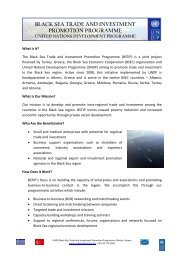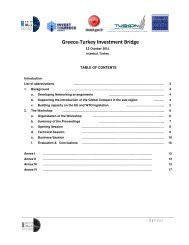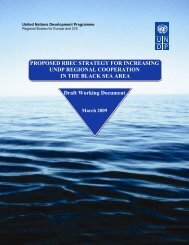Tradeflow Study - UNDP Black Sea Trade and Investment Promotion ...
Tradeflow Study - UNDP Black Sea Trade and Investment Promotion ...
Tradeflow Study - UNDP Black Sea Trade and Investment Promotion ...
Create successful ePaper yourself
Turn your PDF publications into a flip-book with our unique Google optimized e-Paper software.
Executive Summary<br />
The BSEC region has experienced significant macroeconomic, political, institutional <strong>and</strong><br />
regulatory reforms in the last decade, with the effect of dramatically altering the business<br />
environment in which firms operate <strong>and</strong> creating an enabling framework for fostering foreign<br />
investment in emerging manufacturing <strong>and</strong> service sectors.<br />
The Member States of the <strong>Black</strong> <strong>Sea</strong> Economic Cooperation (BSEC) are diverse in terms of<br />
population size, economic power, production <strong>and</strong> export structures, as well as the depth <strong>and</strong><br />
breadth of trade <strong>and</strong> investment policies. The performance of trade is equally disparate, with<br />
Russia, Turkey <strong>and</strong> Greece dominating trade flows, owing in particular to their economic size<br />
since they account for over four fifths of the GDP of BSEC, but also due to the diversification<br />
of their production base. Member States remain predominantly entrenched in merch<strong>and</strong>ise<br />
trade. Total trade in goods represents between 33 percent (Greece) <strong>and</strong> 120 percent of GDP<br />
(Moldova), while total trade in services represents between 8 percent of GDP (Russia) <strong>and</strong> 30<br />
percent of GDP (Moldova). Thus the outward orientation varies between countries though all<br />
countries trade more in goods than services.<br />
The study on trade <strong>and</strong> investment potential for the BSEC is a quantitative analysis of trade<br />
<strong>and</strong> investment flows amongst Member States, <strong>and</strong> identifies a number of sectors in which<br />
trade between Member States is underperforming according to the estimated potentials. The<br />
study draws on a number of trade indicators which are used to calculate trade<br />
complementarity in intra <strong>and</strong> inter industry trade, as well as more classical theoretical<br />
economic models to identify underperformance of trade.<br />
According to the indicators computed in the study, the highest levels of trade complementarity<br />
exist between Azerbaijan (exporter) <strong>and</strong> Ukraine (importer), Greece (exporter) <strong>and</strong> Bulgaria<br />
(importer), Romania (exporter) <strong>and</strong> Ukraine (importer), Russia (exporter) <strong>and</strong> Romania<br />
(importer) <strong>and</strong> Ukraine (importer), <strong>and</strong> Ukraine (exporter) <strong>and</strong> Russia (importer). The level of<br />
intra-industry intra-regional trade for Bulgaria, Romania, Greece, Russia <strong>and</strong> Turkey is<br />
relatively high, whereas it is very low for Albania, Armenia, Azerbaijan, Serbia <strong>and</strong><br />
Montenegro, <strong>and</strong> Ukraine.<br />
Using an econometric model for estimating bilateral untapped potential, a number of key<br />
sectors which present opportunities for intra-regional trade appear to be under exploited. The<br />
7/135






